traction control Oldsmobile Aurora 1998 s User Guide
[x] Cancel search | Manufacturer: OLDSMOBILE, Model Year: 1998, Model line: Aurora, Model: Oldsmobile Aurora 1998Pages: 380, PDF Size: 19.75 MB
Page 204 of 380
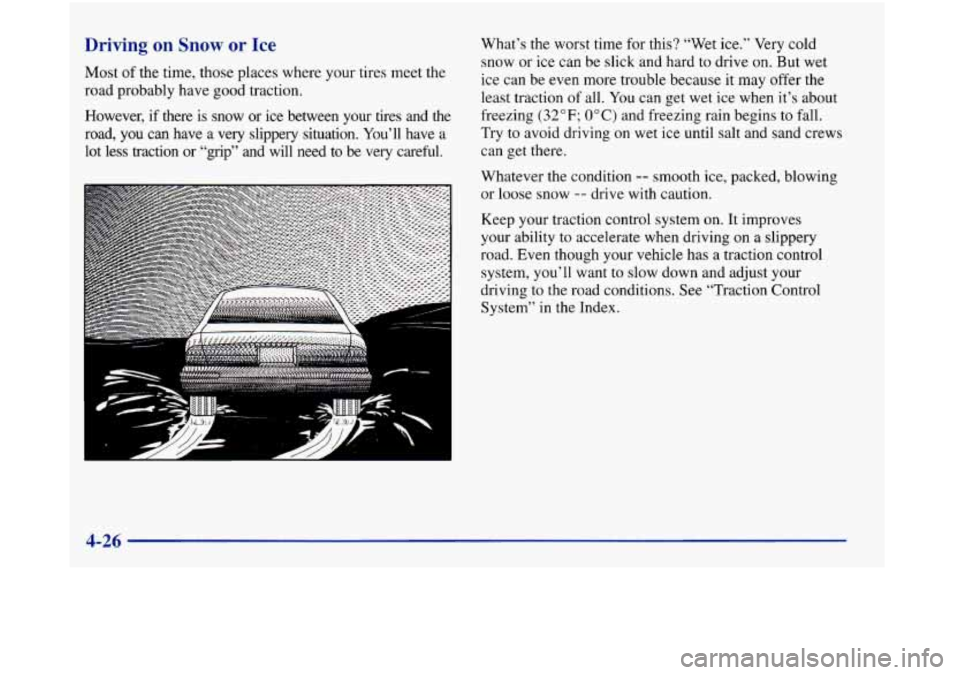
Driving on Snow or Ice
Most of the time, those places where your tires meet the
road probably have good traction.
However, if there is snow or ice between your tires and the
road, you can have a
very slippery situation. You’ll have a
lot less traction or “grip” and will need to be very careful. What’s the worst
time for this? “Wet ice.” Very cold
snow or ice can be slick and hard to drive on. But wet
ice can be even more trouble because it may offer the
least traction of all. You can get wet ice when it’s about
freezing
(32°F; OOC) and freezing rain begins to fall.
Try to avoid driving on wet ice until salt and sand crews
can get there.
Whatever the condition
-- smooth ice, packed, blowing
or loose snow
-- drive with caution.
Keep your traction control system on. It improves
your ability to accelerate when driving on a slippery
road. Even though your vehicle has a traction control
system, you’ll want to slow down and adjust your
driving to the road conditions. See “Traction Control
System” in the Index.
4-26
Page 250 of 380

If You’re Stuck: In Sand, Mud,
Ice or Snow
What you don’t want to do when your vehicle is stuck is
to spin your wheels too fast. The method known as
“rocking”
can help you get out when you’re stuck, but
you must use caution.
If you let your tires spin at high speed, they can
explode, and you or others could be injured. And,
the transaxle or other parts of the vehicle can
overheat. That could cause an engine
compartment fire
or other damage. When you’re
stuck, spin the wheels as little as possible.
Don’t
spin the wheels above 35 mph (55 km/h) as shown
on the speedometer.
NOTICE:
Spinning your wheels can destroy parts of your
vehicle as well as the tires. If you spin the wheels
too
fast while shifting your transaxle back and
forth, you can destroy your transaxle.
For information about using tire chains on your vehicle,
see “Tire Chains” in the Index.
Rocking Your Vehicle To Get It Out
First, turn your steering wheel left and right. That will
clear the area around your fiont wheels.
You should turn
your traction control system off. (See “Traction Control
System”
in the Index.) Then shift back and forth
between REVERSE (R) and a forward gear, spinning the
wheels as little as possible. Release the accelerator pedal
while you shift, and press lightly on the accelerator
pedal when the transaxle
is in gear. If that doesn’t get
you out after a few tries, you may need to be towed out.
If you do need to be towed out, see “Towing Your
Vehicle” in the Index.
5-34
I
I
Page 299 of 380
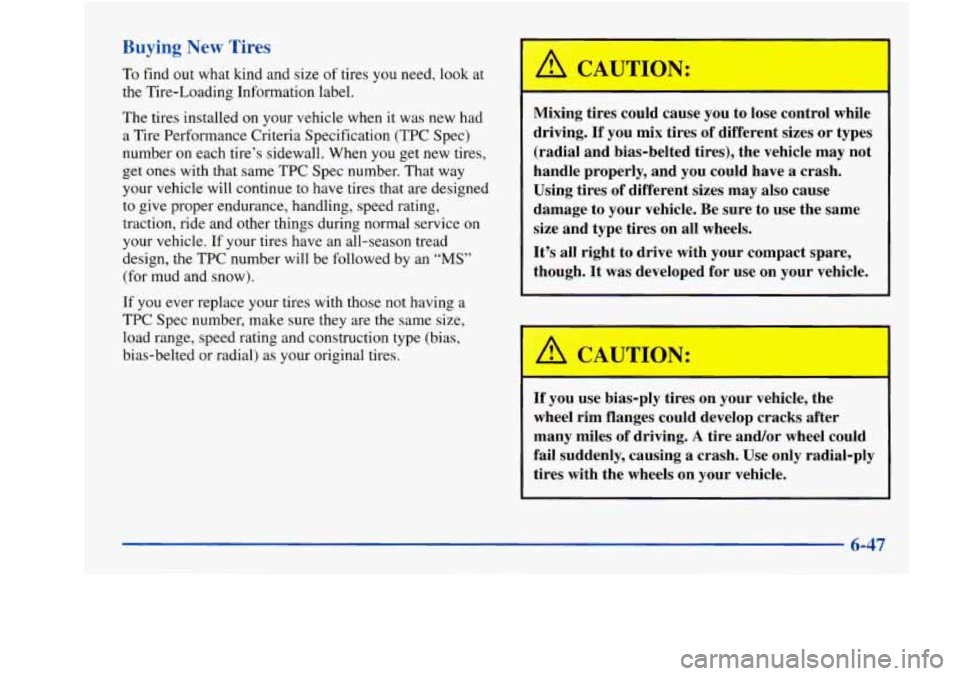
Buying New Tires
To find out what kind and size of tires you need, look at
the Tire-Loading Information label.
The tires installed on your vehicle when it was new had
a Tire Performance Criteria Specification (TPC Spec)
number on each tire’s sidewall. When you get new tires,
get ones with that same TPC Spec number. That way
your vehicle will continue to have tires that are designed
to give proper endurance, handling, speed rating,
traction, ride and other things during normal service
on
your vehicle. If your tires have an all-season tread
design, the
TPC number will be followed by an “MS”
(for mud and snow).
If you ever replace your tires with those not having a
TPC Spec number, make sure they are the same size,
load range, speed rating and construction type (bias,
bias-belted or radial) as your original tires. Mixing tires could cause
you to
lose control while
driving.
If you mix tires of different sizes or types
(radial and bias-belted tires), the vehicle may not
handle properly, and you could have
a crash.
Using tires of different sizes may also cause
damage to your vehicle. Be sure to use the same
size and type tires on all wheels.
It’s all right to drive with your compact spare,
though. It was developed for use on your vehicle.
If you use bias-ply tires on your vehicle, the
wheel rim flanges could develop cracks after
many miles of driving.
A tire and/or wheel could
fail suddenly, causing a crash. Use only radial-ply
tires with the wheels on your vehicle.
6-47
Page 300 of 380
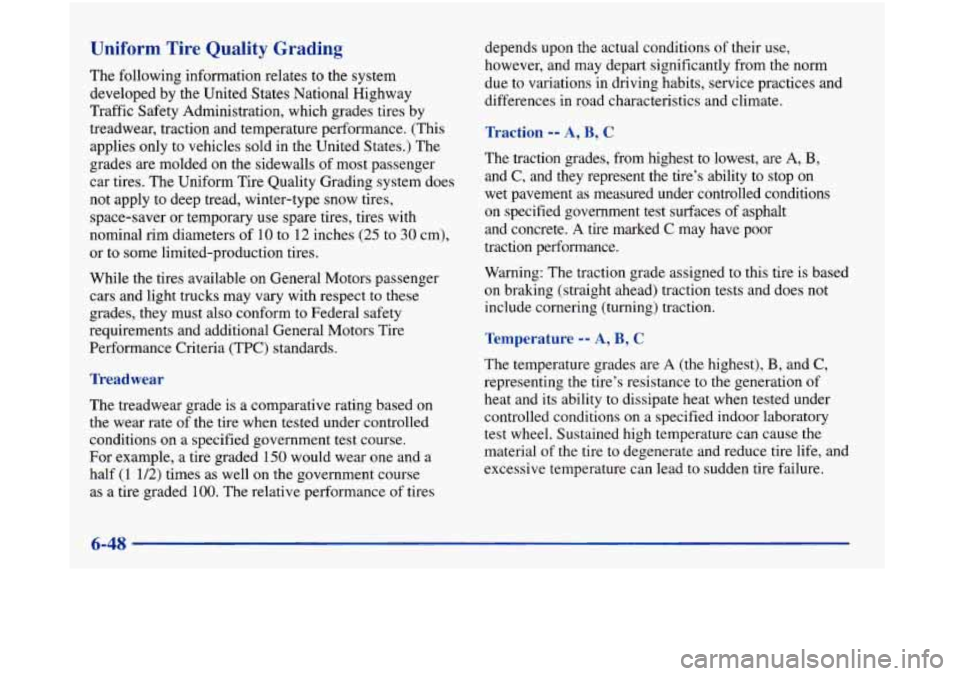
Uniform Tire Quality Grading
The following information relates to the system
developed
by the United States National Highway
Traffic Safety Administration, which grades tires by
treadwear, traction and temperature performance. (This applies only to vehicles sold in the United States.) The
grades are molded on the sidewalls of most passenger
car tires. The Uniform Tire Quality Grading system does
not apply to deep tread, winter-type snow tires,
space-saver or temporary use spare tires, tires with
nominal rim diameters of 10 to 12 inches (25 to
30 cm),
or to some limited-production tires.
While the tires available on General Motors passenger
cars and light trucks may vary with respect to these
grades, they must also conform to Federal safety
requirements and additional General Motors Tire
Performance Criteria (TPC) standards.
Treadwear
The treadwear grade is a comparative rating based on
the wear rate
of the tire when tested under controlled
conditions on a specified government test course.
For example, a tire graded
150 would wear one and a
half (1 1/2) times as well on the government course
as a tire graded 100. The relative performance of tires depends upon
the actual conditions of their use,
however, and may depart significantly from the norm
due to variations in driving habits, service practices and
differences in road characteristics and climate.
Traction -- A, B, C
The traction grades, from highest to lowest, are A, B,
and C, and they represent the tire’s ability to stop on
wet pavement as measured under controlled conditions
on specified government test surfaces
of asphalt
and concrete.
A tire marked C may have poor
traction performance.
Warning: The traction grade assigned to this tire is based
on braking (straight ahead) traction tests and does not
include cornering (turning) traction.
Temperature -- A, B, C
The temperature grades are A (the highest), B, and C,
representing the tire’s resistance to the generation of
heat and its ability
to dissipate heat when tested under
controlled conditions on a specified indoor laboratory
test wheel. Sustained high temperature can cause the
material of the tire to degenerate and reduce tire life, and
excessive temperature can lead to sudden tire failure.
6-48
Page 368 of 380
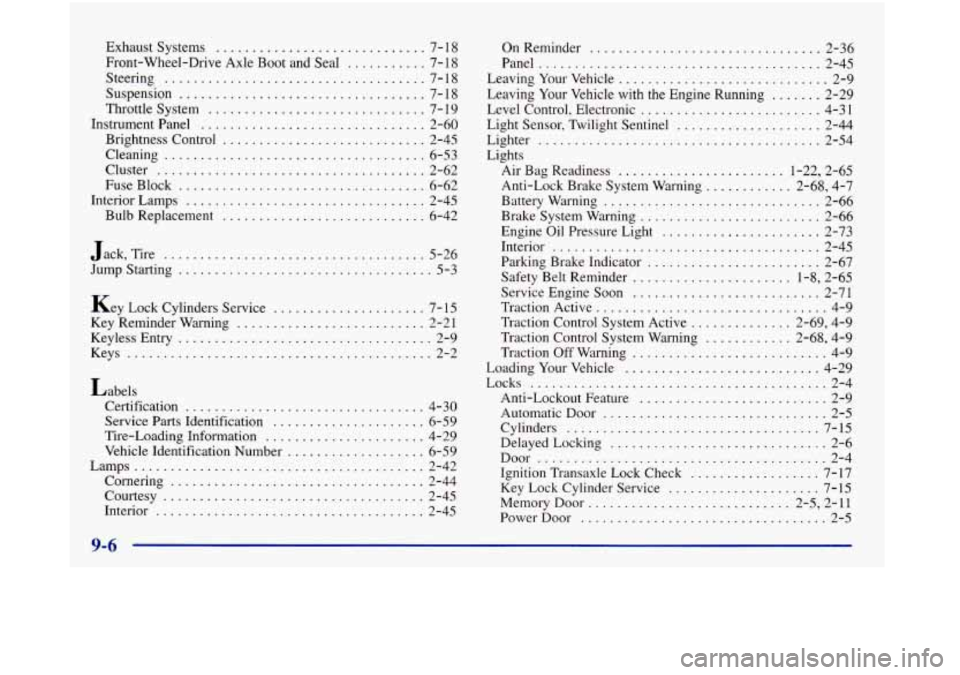
Exhaust Systems ............................. 7- 18
Front-Wheel-Drive Axle Boot and Seal
........... 7- 18
Steering
.................................... 7-18
Suspension
.................................. 7-18
Throttle System
.............................. 7- 19
InstrumentPanel ............................... 2-60
Brightness Control
............................ 2-45
Cleaning
.................................... 6-53
Cluster
..................................... 2-62
FuseBlock
.................................. 6-62
Interior Lamps
................................. 2-45
Bulb Replacement
............................ 6-42
.................................... J ack. Tire 5-26
Jump Starting
................................... 5-3
Key Lock Cylinders Service ..................... 7-15
Key Reminder Warning .......................... 2-21
Keyless Entry
................................... 2-9
Keys
.......................................... 2-2
Labels Certification
................................. 4-30
Service Parts Identification
..................... 6-59
Tire-Loading Information
...................... 4-29
Vehicle Identification Number
................... 6-59
Lamps
........................................ 2-42
Cornering
................................... 2-44
Courtesy
.................................... 2-45
Interior
..................................... 2-45 OnReminder
................................ 2-36
Panel
....................................... 2-45
Leaving Your Vehicle
............................. 2-9
Level Control. Electronic
......................... 4-31
Light Sensor. Twilight Sentinel
.................... 2-44
Lighter ....................................... 2-54
Lights Air Bag Readiness
....................... 1-22. 2-65
Battery Warning
.............................. 2-66
Brake System Warning
......................... 2-66
Engine Oil Pressure Light
...................... 2-73
Interior
..................................... 2-45
Parking Brake Indicator
........................ 2-67
Safety Belt Reminder
...................... 1.8. 2.65
Service Engine Soon
.......................... 2-71
Traction Active
................................ 4-9
Traction Control System Active
.............. 2.69. 4.9
Traction Off Warning
........................... 4-9
Loading Your Vehicle
........................... 4-29
Anti-Lockout Feature
.......................... 2-9
Automatic Door
............................... 2-5
Cylinders ................................... 7-15
DelayedLocking .............................. 2-6
Door
........................................ 2-4
Ignition Transaxle Lock Check
.................. 7-17
Key Lock Cylinder Service
..................... 7-15
Memory Door ............................ 2.5. 2.11
PowerDoor
.................................. 2-5
Leaving Your Vehicle with the Engine Running ....... 2-29
Anti-Lock Brake System Warning
............ 2.68. 4.7
Traction Control System Warning
............ 2.68. 4.9
Locks
......................................... 2-4
Page 373 of 380
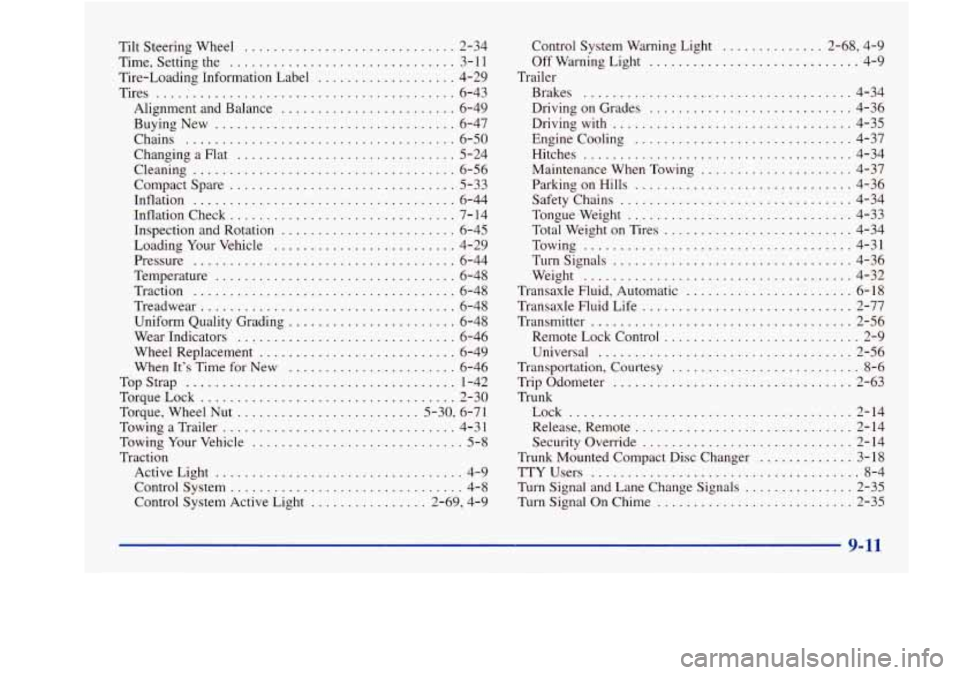
.
Tilt Steering Wheel ............................. 2-34
Time. Setting the
............................... 3-1 1
Tire-Loading Information Label
................... 4-29
Tires
......................................... 6-43
Alignment and Balance
........................ 6-49
BuyingNew
................................. 6-47
Chains
..................................... 6-50
Cleaning
.................................... 6-56
Compact Spare
............................... 5-33
Inflation
.................................... 6-44
Inflation Check
............................... 7- 14
Inspection and Rotation
........................ 6-45
Loading Your Vehicle
......................... 4-29
Pressure
.................................... 6-44
Temperature
................................. 6-48
Traction
.................................... 6-48
Treadwear
................................... 6-48
Uniform Quality Grading
....................... 6-48
Wear Indicators
.............................. 6-46
Wheel Replacement
........................... 6-49
When It’s Time
for New ....................... 6-46
TopStrap
..................................... 1-42
TorqueLock
................................... 2-30
Torque. Wheel Nut
......................... 5-30. 6-71
TowingaTrailer
................................ 4-31
Towing Your Vehicle
............................. 5-8
Traction ActiveLight
.................................. 4-9
Control System
................................ 4-8
Control System Active Light
................ 2-69. 4-9
Changing a Flat
.............................. 5-24
Control
System Warning Light
.............. 2.68. 4.9
Off Warning Light
............................. 4-9
Brakes
..................................... 4-34
Driving on Grades
............................ 4-36
Drivingwith
................................. 4-35
Engine Cooling
.............................. 4-37
Hitches
..................................... 4-34
Maintenance When Towing
..................... 4-37
Parking on Hills
.............................. 4-36
Safety Chains
................................ 4-34
Tongueweight
............................... 4-33
Total Weight on Tires
.......................... 4-34
Towing
..................................... 4-31
Turnsignals
................................. 4-36
Weight
..................................... 4-32
Transaxle Fluid. Automatic
....................... 6-18
Transaxle Fluid Life
............................. 2-77
Transmitter
.................................... 2-56
Remote Lock Control
........................... 2-9
Universal
................................... 2-56
Transportation. Courtesy
.......................... 8-6
Trip Odometer
................................. 2-63
Trunk Lock
....................................... 2-14
Release. Remote
.............................. 2-14
Security Override
............................. 2-14
Trunk Mounted Compact Disc Changer
............. 3-18
TTYUsers
..................................... 8-4
Turn Signal and Lane Change Signals
............... 2-35
Turn Signal On Chime
........................... 2-35
Trailer
9-11